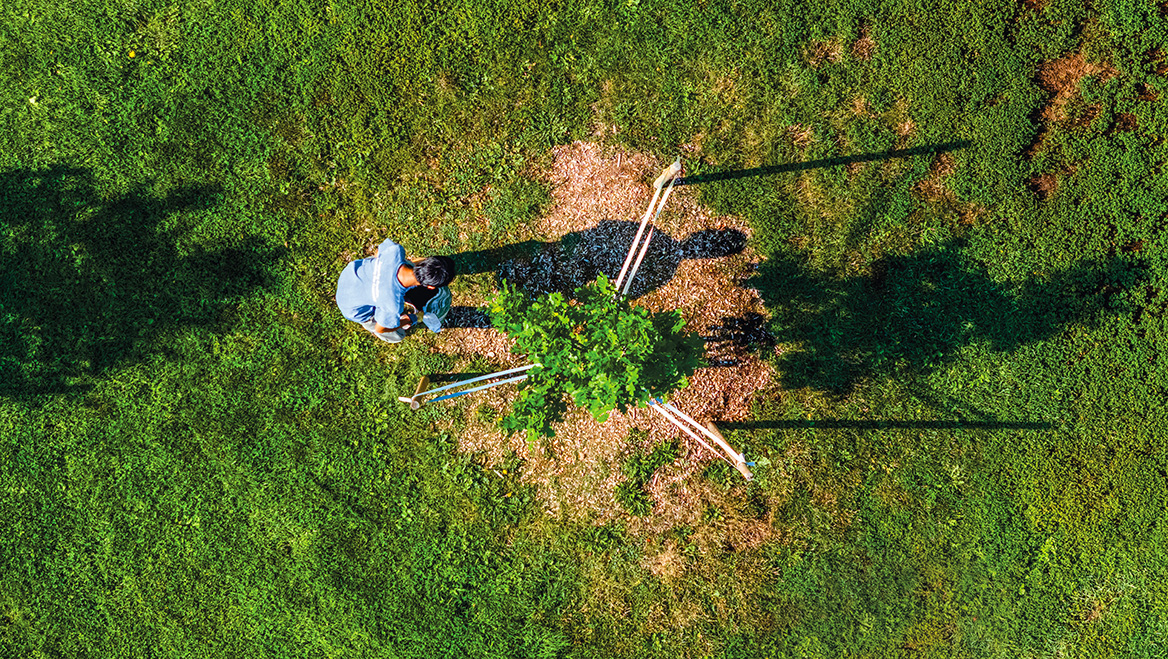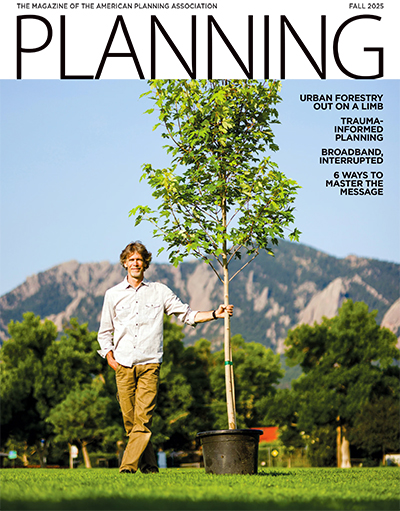Sept. 18, 2025
Earlier this year in Butte, Montana, urban forester Trevor Peterson experienced the best — and worst — days of his career within two weeks.
In February, Peterson learned the Arbor Day Foundation had awarded the city an additional $600,000 in Inflation Reduction Act (IRA) grant money from the Department of Agriculture (USDA) Forest Service, on top of the $142,000 he had secured in late 2024 to remove 175 hazardous cottonwoods from the city's most popular public park and install three replacements for every tree removed.
"We were finally catching up after a hundred years of not planning for trees," says Peterson, the first tree professional in Butte's history.
Two weeks later, the federal grant funds were frozen before a final termination notice was given amid a Trump administration rollback of IRA-funded grants tied to diversity, equity, and inclusion initiatives.
Peterson and Butte residents were devastated. For much of the city's history, mining and smelting industries used it as a dumping site, leaving its land and streams contaminated and neighborhoods nearly treeless. In the 1980s, Silver Bow Creek was declared the nation's largest Superfund site and remediation efforts began. Progress was made, but trees still struggle to grow, and city investment in and knowledge about trees — and their importance to the urban fabric — have suffered.
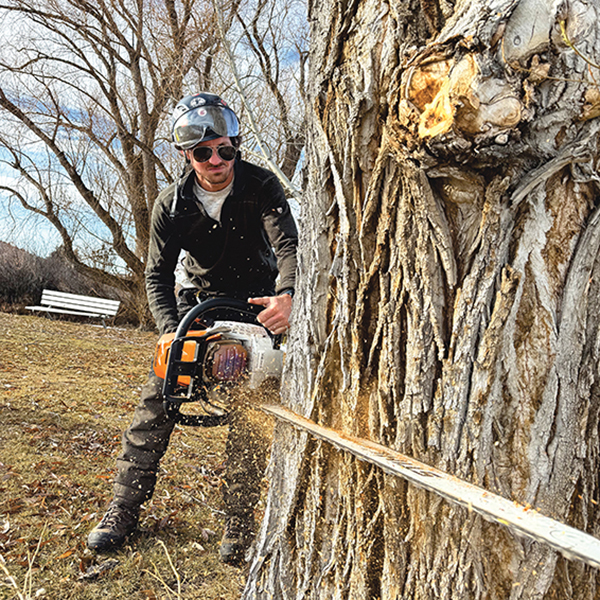
Trevor Peterson, the urban forester for Butte, Montana's parks and recreation department, says that work to remove and replace old cottonwood trees stopped in early 2025.
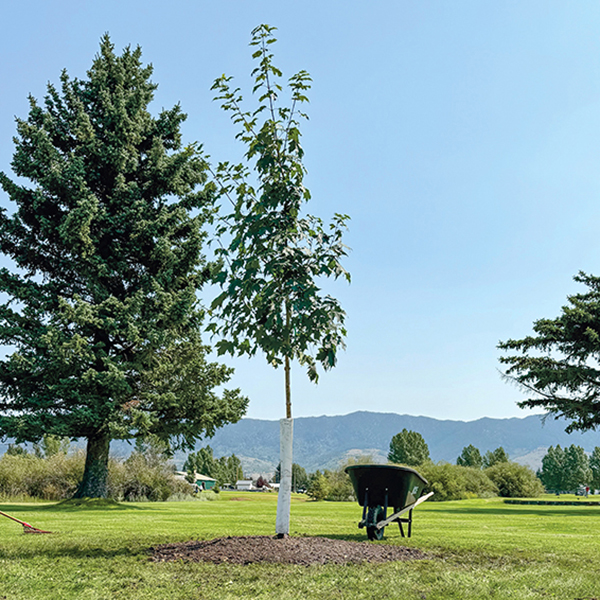
Before the Inflation Reduction Act grant funding was frozen, Butte was able to purchase professional-grade equipment and add a range of tree species to its parks. Photos courtesy of Trevor Peterson.
Butte's Urban Forestry Division of the Parks and Recreation Department operates on a city budget of $1,200 to $3,000 a year. "Everything else, I have to go out and get myself," Peterson says. Before the IRA grant, he had been awarded 14 grants over five years, the largest totaling $12,000.
The additional IRA grant funds would have helped to hire interns and additional seasonal staff, which would have given Peterson time to update Butte's 10-year urban forest master plan, already two years overdue. Without the funding support, progress has stalled, and Peterson has been left juggling many ongoing projects.
The federal government reimbursed about $50,000 of Butte's original grant before canceling the Arbor Day Foundation's IRA funding. That money was used to purchase professional-grade equipment and remove 68 of the dead or dying trees, as well as buy and plant almost 200 new replacement trees. However, more than 100 dangerous trees remain standing — some with only half an inch of live wood holding them upright — and Peterson doesn't have the resources to finish the job.
"You never want to have hazardous trees in any park," he says. "If a tree fell and injured somebody, I would never forgive myself."
Boom to bust
Butte's experience mirrors a broader national trend: Cities across the country are struggling to keep tree canopy initiatives alive amid federal funding instability.
It's vastly different from the atmosphere in 2023, when urban forestry advocates celebrated the IRA's passage. The legislation earmarked $1.5 billion for the USDA Forest Service's Urban and Community Forestry (U&CF) Program — a historic infusion of funds intended to support planting and caring for trees in low-canopy, historically underserved neighborhoods, which suffer disproportionately from urban heat islands, poor air quality, and related health problems, as well as stormwater issues. The funds were awarded to 12 pass-through organizations, such as the Arbor Day Foundation, to distribute via grants to local communities and projects.
"These communities have long been waiting for this kind of relief," says Beattra Wilson, PhD, then-assistant director for cooperative forestry at the U.S. Forest Service, during a keynote at the 2023 Hixon Center Urban Conference shortly after USDA awarded $1 billion of that funding as grants to 385 communities. Another $250 million was earmarked for states to distribute.
That momentum faltered in early 2025 when the Trump administration froze and then cut billions in grants, including approximately $75 million in U&CF funds administered by the Arbor Day Foundation.
"Lawsuits challenging the cuts might eventually restore some urban forestry funding, as cities and states brace for what could be a permanent recalibration of federal support."
The IRA funding for urban forestry "was a recognition that we have historically not invested sufficiently in this critical infrastructure, and it was just walked back," says Brett KenCairn, planner and senior policy advisor for climate and environment for Boulder, Colorado, and founder of the nonprofit Center for Regenerative Solutions.
The full scope of the cuts remains unclear. In June, the USDA announced it had cut $148.6 million in funding for more than 145 awards, including a $192,246 project to "create a new urban model for urban forestry to lead environmental justice through more equitable distributed green spaces," but the press release was light on details. At press time, the USDA Forest Service had neither published nor responded to Planning requests for a comprehensive list of canceled awards or the total amount of urban forestry funding that has been rescinded.
Two of the 12 U&CF pass-through organizations — the Arbor Day Foundation and Urban Sustainability Directors Network (USDN) — have sued USDA to have their grants reinstated. Funding for others, such as American Forests, remains in place. The same uncertainty applies to IRA dollars distributed to states for local tree efforts through the program.
Even harder to quantify are the ripple effects from cuts to agencies beyond forestry. For example, the Environmental Protection Agency, which supports urban forestry in addition to other environmental and climate programs, recently canceled more than 600 environmental justice grants worth $2.4 billion.
Back to square one
Hundreds of local initiatives are now back where they started. Officials from Cary, North Carolina, told Planning in a statement that it had discontinued its Branching Out program after losing a $1 million federal grant. Others, like the Sustaining Our Urban Landscape (SOUL) reforestation initiative in New Orleans, have paused operations while they patch together resources to stay afloat. Advocates say the fallout will be far-reaching and long-lasting.
"After decades of research, we know that every dollar spent on tree planting and care provides 10 times a return on investment in terms of improvements to human health, reduced wear-and-tear on infrastructure, lower energy bills, absorbing the acute impacts from extreme heat and flooding, and dozens of other societal benefits," Vivek Shandas wrote in an email to Planning.
Shandas, a professor at Portland State University and a member of the National Urban and Community Forestry Advisory Council, warns that the federal cuts will result in measurable harm to communities, especially those already facing health, economic, and environmental challenges.
SOUL's executive director, Susannah Burley, agrees. "Trees are barometers for wealth and health, and areas with concentrated poverty don't have them," she says.

Susannah Burley (above) leads Sustaining Our Urban Landscape (SOUL) in New Orleans, whose volunteers plant and maintain trees in areas of the city devastated by Hurricane Katrina in 2005, including the Lower Ninth Ward. Photos courtesy of Arbor Day Foundation; briannolan/iStock/Getty Images Plus.
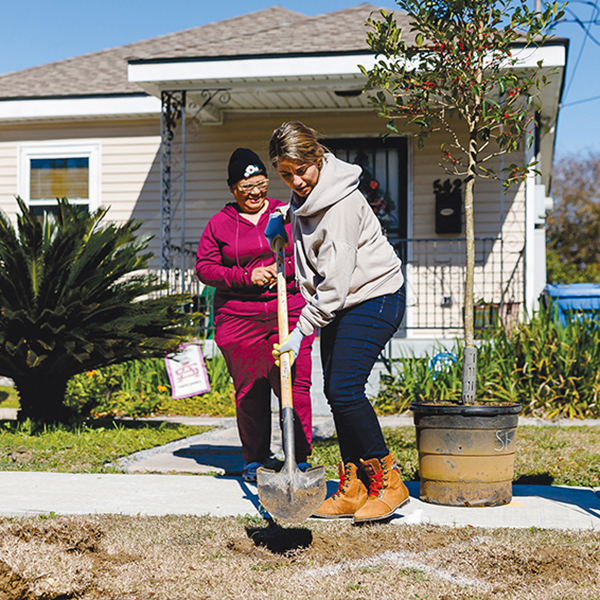

Her organization was a year into implementing New Orleans's $12.5 million reforestation plan when its grant, administered through the Arbor Day Foundation, was canceled. The goal of the plan, which won an American Society of Landscape Architects Honor award in 2023, is to grow the tree canopy by at least 10 percent of its landscape. Funding comes from local allocations, bonds, private foundations, corporate donors, and federal grants.
"The Arbor Day Foundation grant was game-changing," Burley says. It would have allowed SOUL to finish planting in the Lower Ninth Ward, the neighborhood hit hardest by Hurricane Katrina.
The grant cancellation forced the organization to cancel tree orders and suspend planting operations. SOUL was a week from closing when the Bloomberg Foundation awarded SOUL a $250,000 emergency grant in April 2025. SOUL plans to use part of the money to fund watering efforts for trees SOUL already planted — a critical investment as 34 percent of street trees die within two years — and resume planting in the Lower Ninth next season. SOUL has also hired a development staffer to fundraise locally.
"We don't have the strongest economic base here," Burley says. "The same small group of funders is hit up by everyone. There's only so much to dole out, but people from New Orleans love to support New Orleans."
Saved by coalition
In Ohio, the Cleveland Tree Coalition lost a $600,000 Arbor Day Foundation grant intended for public education, engagement, and outreach — one of four priority areas in its ambitious five-year strategic plan, which was developed between 2022 and 2023.
"It was a very different time in the urban forestry federal funding landscape," Sara Tillie, the coalition's director, says.
Fortunately, the coalition operates on a collective impact model, which provides insulation from shifting federal priorities. Originally developed by social scientists, the collective impact model aligns diverse organizations with shared goals. According to Tillie, who worked in public health before earning her master's in urban planning, the model makes a lot of sense for all kinds of community-based work.
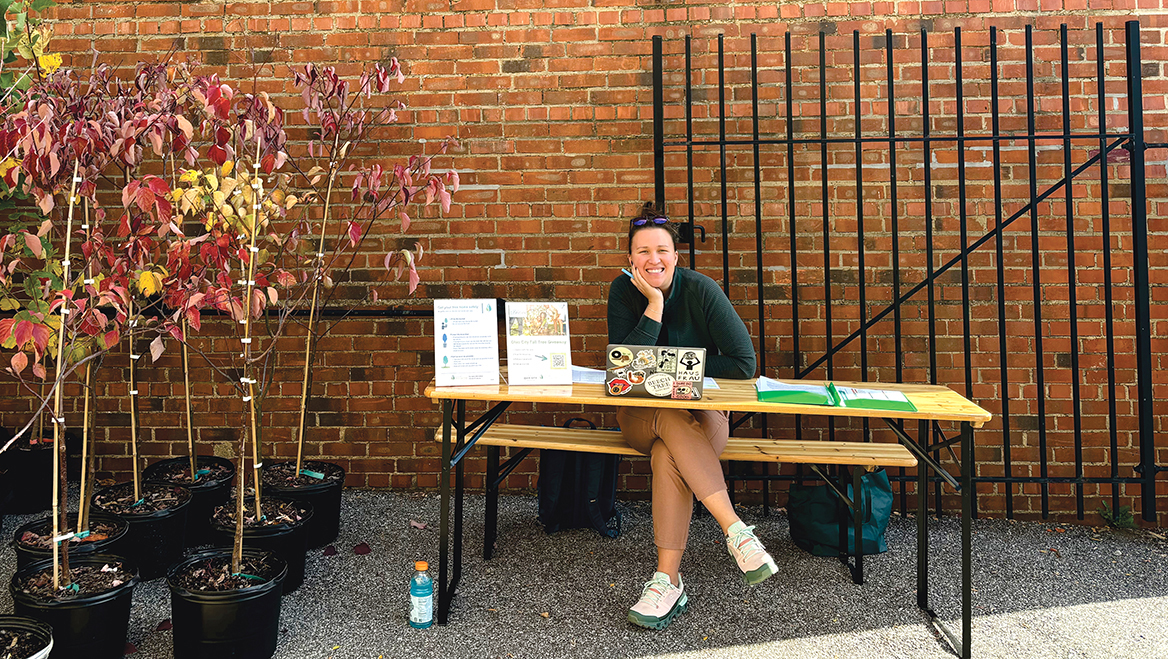
Planner Sara Tillie (above) is the director of the Cleveland Tree Coalition, a collective that recently lost a major Arbor Day grant. It is nonetheless finding a path forward, in part because of their collective funding model, which relies on partnerships to fund its work across the city. Photos courtesy of Cleveland Tree Coalition.
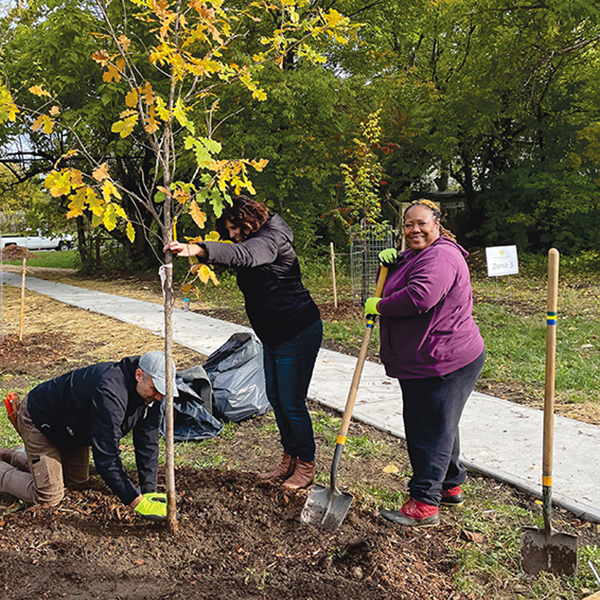
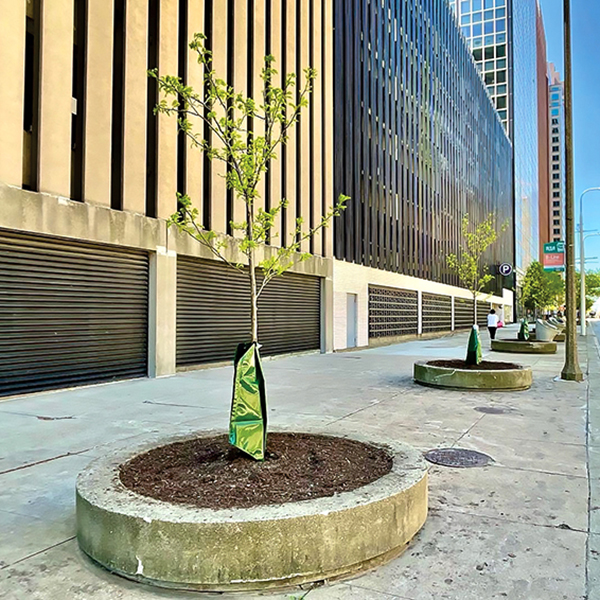
"We have a structure in place where there's trust and partnership," Tillie says. "We've been talking about how we can stitch together little pockets of funding or people to solve for the holes left behind by federal cuts."
The model relies on nonprofits, city agencies, businesses, and academic institutions contributing different resources. Each partner brings something different — lobbyists, viewpoints, access to funds. "That is just so vital to us in finding paths forward," she says.
Individual coalition members still face their own challenges. For example, a few partners took a staffing hit when the Trump administration terminated nearly $400 million in grant program funding from AmeriCorps. "But the collective structure makes it possible to adapt as a whole," Tillie says.
A path forward
With more federal cuts looming, urban forestry advocates are bracing for continued instability. "I wouldn't apply for any other federal funding that's reimbursable-based during this administration," says SOUL's Burley.
Waiting for more favorable political winds, though, isn't always a viable option — especially in a field where progress takes decades.
Some states and cities have stepped up. Massachusetts launched its Cool Corridors grant program in March, awarding $1.3 million for shade-tree planting in heat-vulnerable areas. Seattle expanded municipal reforestation efforts in July. Other cities introduced local greening legislation.
Still, there's no substitute for sustained federal investment.
"We ultimately have to see this as a local priority," says KenCairn, who leads Boulder's nature-based solutions team and has a master's degree in urban planning. "It has to be part of what we recognize as critical infrastructure."
That shift requires mindset changes and structural reforms. Advocates say building broad coalitions, supporting public-private partnerships, and investing in local capacity will be key to long-term resilience.

Alana Tucker, AICP, and her Tree Equity Alliance team connect cross-sector interests, like public health, transportation, housing, energy, and equity. Photo courtesy of Alana Tucker.
"Urban forests don't just happen," says Alana Tucker, AICP, senior director of tree equity strategy and partnerships at American Forests, one of the 12 U&CF passthrough organizations. (Tucker also is a policy co-chair for APA's Sustainable Communities Division.)
Through American Forests' Tree Equity Alliance, her team aims to connect urban forestry to all sectors, including the built environment, to help build policy and funding models that treat trees as living infrastructure. Tools like the Tree Equity Score help cities map canopy coverage alongside heat risk, income, and health vulnerabilities.
"Trees sit at this beautiful intersection of so many mutual and aligned interests — public health, transportation, housing, energy, equity," Tucker says, adding that urban forestry advocates need to tap into that intersectionality to make the case that trees are living infrastructure in our cities and need to be funded as such.
That kind of cross-sector effort is already underway in Boulder, Colorado, where local partnerships — not federal dollars — sustain the city's Community Forestry Corps. Launched in 2024 as a pilot for a scalable program developed by the USDN, Boulder hires young people to plant and care for trees in heat-vulnerable neighborhoods while collecting data about their impact.
In early 2024, USDN awarded grants to help 15 cities nationwide launch similar programs, but Boulder's effort wasn't eligible: Conflict-of-interest rules prevented funding because a city staffer had helped design the program.
"I was just like, 'are you kidding me?' We were the ones who provided the proof of concept," KenCairn says. "So we said we're going to figure out a way to fund it ourselves. Which, it turns out, was a good thing. We're running a program this summer, and nobody else is."
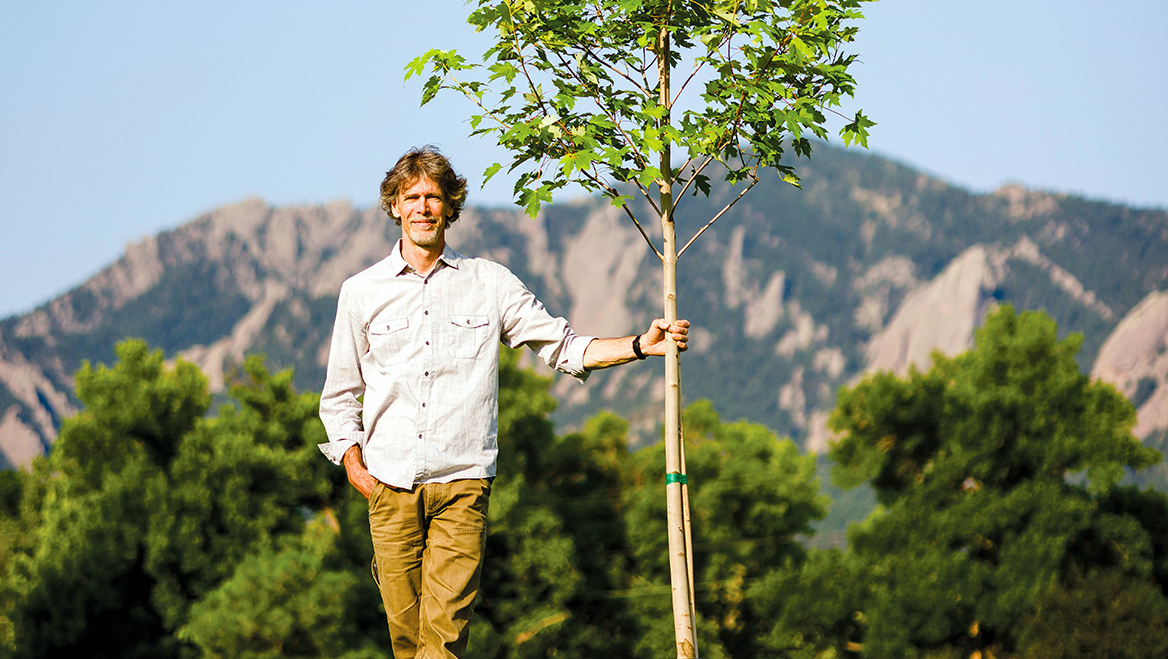
Young people from the Community Forestry Corps help plant and water trees on a school site (below) in Boulder, Colorado, in August 2025. To supply the water, Boulder planner and Senior Climate Policy Advisor Brett KenCairn (above) found an innovative temporary watering technique that relies on fire hydrants. Photos by Michael Ciaglo.
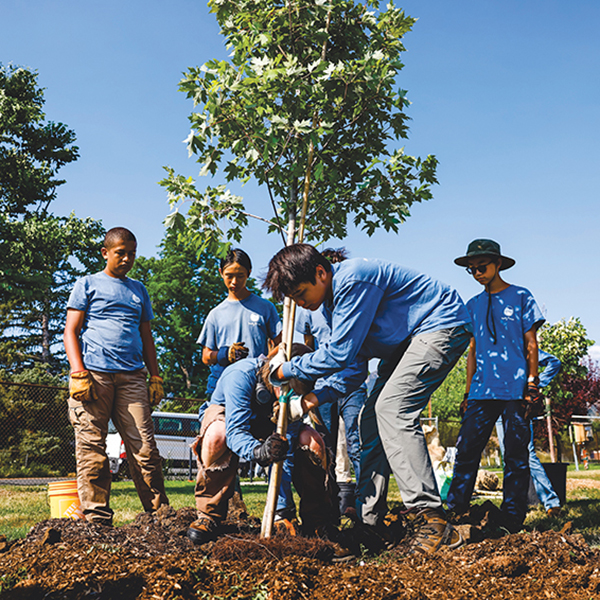
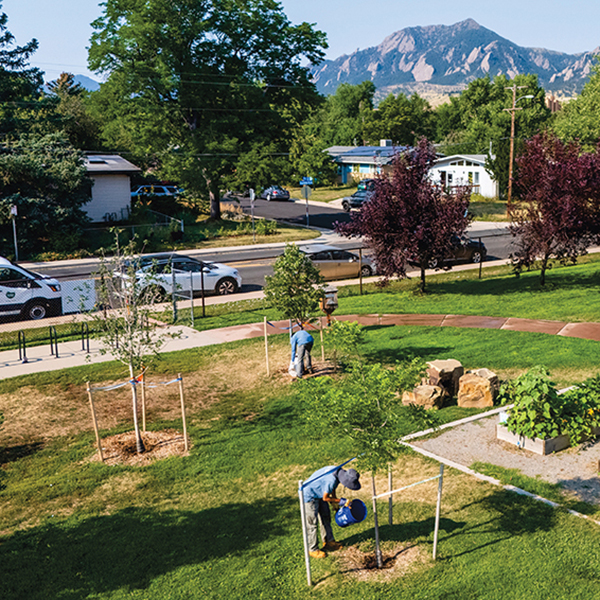
To fund the program, Boulder turned to its existing local network of urban forestry stakeholders. The Play Boulder Foundation, a member of the larger Cool Boulder Campaign, stepped up to run and fund the corps through its Tree Trust program. Cool Boulder is a coalition of 50 local nonprofit organizations and private companies that launched in 2022 to work collaboratively with city departments to expand urban forestry and promote what KenCairn describes as a long-term local "culture of care" for trees and urban landscapes.
"We have to remember that cities typically control less than 20 percent of the natural infrastructure of a community, so we have think about how we set up entities, infrastructure, and capacity to motivate and support activity in the private sector as well," he says. "None of it works without having that infrastructure community support already in place."
Bracing for final impact
Back in Butte, Peterson is patching together what he can. He hopes to keep building his department's budget through local channels and additional public and private grants, but it won't come close to replacing what was lost.
"That IRA money was going to set us up," Peterson says. He hopes to finish his career in Butte. "Without it, I'm not going to make near as much progress as I want. I feel like I'm failing every day. So much needs to be done."
Lawsuits challenging the cuts might eventually restore some urban forestry funding, but no one is counting on it. At press time, the president's proposed fiscal year 2026 budget would cut the U.S. Forest Service's discretionary budget by 65 percent and eliminate its State, Private, and Tribal Forestry Program — a key source of assistance for non-federal forest owners and local communities alike.
The Forest Service's budget request framed the move as a shift in responsibility, saying it will "ensure fiscal responsibility with American taxpayer dollars and to better balance the appropriate roles of federal and state governments," and "that local governments should be empowered to fund their urban forestry efforts in alignment with local priorities."
That rationale signals a likely trend for the remainder of this administration, as cities and states brace for what could be a permanent recalibration of federal support.



